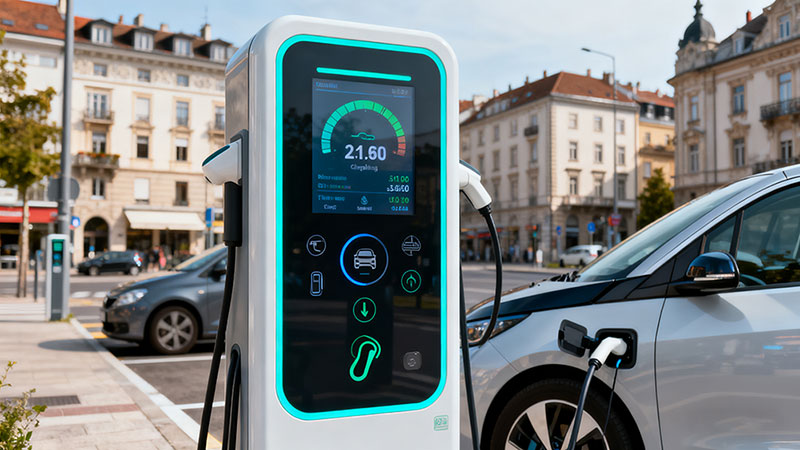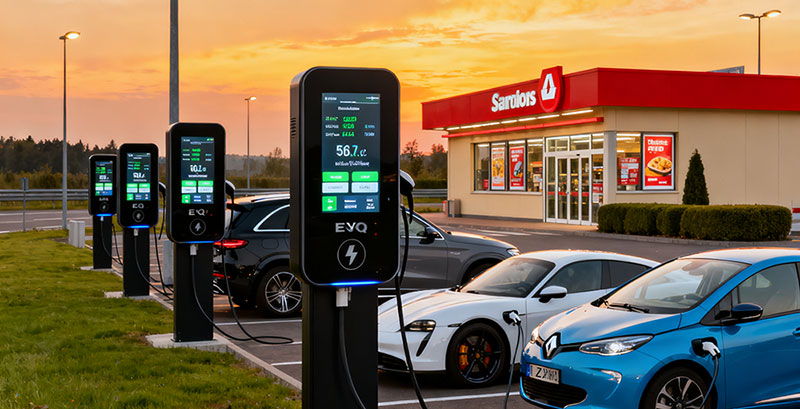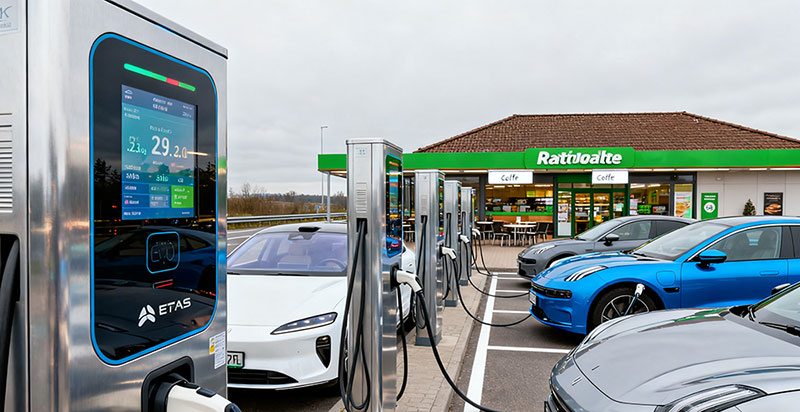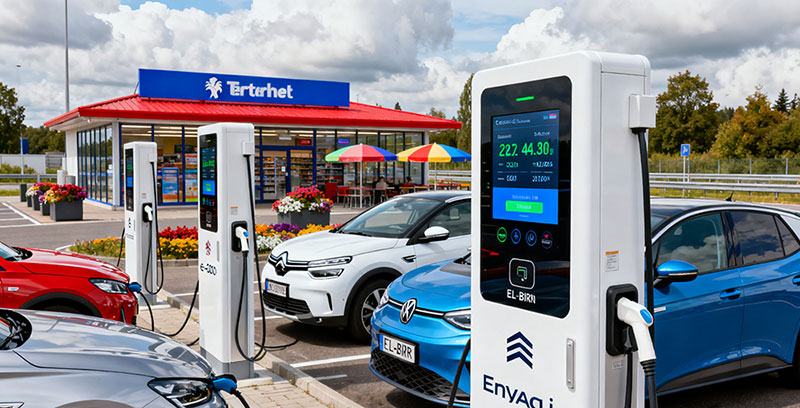Executive summary — why this matters now
Europe’s public charging network is expanding rapidly and—critically—unevenly. As charging networks scale to meet driver demand, the visual and interactive surface presented at each charger (the display) is no longer an afterthought: it’s a functional HMI, a safety device, a revenue channel, and a brand touchpoint. Distributors who understand the technical requirements, standards compliance, and commercial opportunities for outdoor, sunlight readable EV charging station displays will be able to advise integrators and operators, win larger bundled deals, and unlock recurring revenue models (service, software, advertising). Recent market analysis and industry initiatives confirm the urgency: Europe passed ~1 million public charging points in 2024, but still needs a much faster rollout pace to hit 2030 goals — a gap that translates into millions of display-equipped chargers to be specified and supplied.
Market context and demand signals (European data & forecasts)
Why the display matters at an EV charger — functions and KPIs
Key technical requirements for outdoor EV charging displays
Standards, safety & regulatory considerations (what distributors must check)
Connectivity, software and the DOOH opportunity
Case studies & industry examples (what’s working in Europe)
Commercial models & pricing considerations for distributors
Procurement checklist & sample specification (copy/paste for RFQs)
Installation, maintenance and lifecycle considerations
Sales messaging and positioning for European distributors
Appendix: reference standards, market sources, and glossary
Europe’s public charging infrastructure is in growth mode but still needs rapid scale-up. The International Energy Agency’s Global EV Outlook notes the European public charging fleet exceeded 1 million public charging points in 2024, growing more than 35% year-on-year. That rapid growth carries immediate demand for outdoor rated displays at each location, especially for fast-charging sites and urban curbside chargers where user clarity is essential.
Independent industry research and regional reports estimate even more ambitious buildout needs to meet EU targets: some reports indicate Europe will require several million more chargers by 2030 (one dataset places the 2030 target around 8.8 million chargers required to meet demand), implying large long-term demand for displays, mounting hardware, and CMS integrations.
Beyond pure charging demand, new revenue models have emerged: digital-out-of-home (DOOH) and advertising platforms are being integrated with charging sites to monetize dwell time and offset capex, with vendors and networks (e.g., Broadsign partners, regional operators) actively deploying ad-enabled screens at charge points across Europe. That makes display selection a commercial as well as a technical decision.
Key takeaways for distributors:
Short term: growing retrofit and new-install opportunities as public and private operators expand. (~1M+ existing public chargers in 2024).
Medium term: network-scale opportunities driven by alliances and consolidation (large operators forming pan-European networks).
Adjacent revenue: advertising/DOOH and software platforms create recurring revenue opportunities beyond hardware.

A modern EV-charging display fulfills multiple roles simultaneously. Understanding these is essential when pitching to integrators and operators.
Primary functional roles
User interface (HMI): shows charge status, session pricing, connector status, instructions, and prompts for payment or authentication. It must be readable in direct sun, visible at different viewing angles, and responsive to touch or alternative controls.
Safety & compliance display: must clearly show warnings, emergency cut-offs, and status that could have safety implications (e.g., “Stop charging — connector fault”).
Commercial surface/DOOH: supports static or video ads, retailer promos, or cross-sell content during dwell times—turning screens into revenue generators.
Branding & UX continuity: displays are a front-line brand experience—consistent, reliable displays improve perceived reliability of the charging network.
Operational KPIs impacted by displays
Successful session starts (reduce user confusion at station)
Average session time spent on payment/authentication (lower friction = higher throughput)
Ad revenue per charger (when applicable)
Service ticket volume related to in-field display failures (MTTR & reliability influence TCO)
Commercial value mapped to technical attributes
Bright, sunlight-readable screens reduce user errors and support faster sessions.
Industrial reliability (temperature and humidity tolerance, long MTBF) lowers maintenance costs and service visits.
Open CMS/remote management enables ad monetization and reduces manual content updates.
Distributors must specify displays that reliably operate in harsh outdoor conditions while meeting usability and regulatory needs. Below are the technical dimensions to include in any RFQ or buyer recommendation.
Sunlight readable brightness: Aim for a minimum of 1,500–2,500 nits for semi-sunny locations; high-sun or window-exposed mounting (direct midday sun) often requires 3,000–5,000 nits for consistently legible content. Several industrial outdoor displays reach up to 5,000 nits and include automatic brightness control.
Anti-glare treatments & optical bonding: Optical bonding reduces internal reflections and improves contrast; anti-glare coatings reduce specular reflections—both are important on high-angle sun exposures.
High contrast ratio (≥ 1000:1 preferred) and wide viewing angles (IPS or similar panel tech) ensure the display is readable from different approach vectors (kerbside approach, driver seat, pedestrian view).
Operational range: outdoor chargers can see from below −20°C to above +60°C. Industrial displays are often specified to operate in ranges such as −20°C to +70°C, with tested cycles for extremes. Look for displays with active or passive thermal management and heat-tolerant backlights.
IP65 / IP66 or better for housings to be safe around rain spray and cleaning. For exposed or roadside sites, consider IK10 impact rating for vandal resistance where appropriate.
Projected capacitive (PCAP) touch provides good responsiveness and works with gloved hands (important in colder countries). Resistive touch is cheaper but less future-proof.
Consider glove modes, waterproof touch detection, and tamper-resistant glass.
CE and RoHS compliance are mandatory in EU markets; evidence of EMC testing, safety testing, and environmental cycle tests (thermal shock, salt spray for coastal deployments) are essential. Some manufacturers publish temperature cycle data and backlight MTBF (e.g., 50,000 hours) that distributors should request.
Network: Ethernet + cellular (4G/5G fallback) + optional Wi-Fi for content sync and payment systems.
Edge compute: Many operators require local playback engines, secure boot, and containerized apps (Android, Linux) for payment clients, telemetry, and ad playback. Ensure the display platform supports remote management (CMS) and OTA firmware updates.
Displays should be optimized for low energy use (auto-dimming, presence sensors—reduce power draw when not in use). For charging points with constrained power budgets (e.g., off-grid or solar hybrid), choose displays with adaptive brightness and low idle consumption.
Backlight MTBF and expected lifetime (e.g., 50,000 hours) are important for TCO calculations. Design for easy field replacement of modules (PCB, controller) to reduce downtime.

As a distributor, the buyer will expect you to deliver displays that are compliant and that don’t create integration headaches. Key standards and guidelines:
IEC 61851 family (particularly IEC 61851-1) defines general requirements for conductive EV charging systems. While the IEC standard focuses more on charging hardware and safety, your display and its interactions with the charger must not interfere with safety signaling and must be integrated in accordance with relevant EMC and safety practices.
CEN/CENELEC provide regional guides and harmonization references for EU markets — distributors should reference CEN-CENELEC guides when advising on European norms.
Displays integrated into charging kiosks must pass EMC testing to ensure that the display electronics do not interfere with metering or control systems. Insist on CE declarations of conformity and test reports.
Accessibility (height/angle for visually impaired users) and local signage rules may apply in certain municipalities. European procurement often evaluates environmental compliance (RoHS, WEEE directives) and recyclability.
If the display handles payment flows or persistent user data, compliance with GDPR and PCI standards (if card data passes through the display/controller) must be documented. Distributors should require the integrator or operator to clarify where payment processing occurs and ensure the display's OS supports secure partitioning.
Displays are hardware; the real long-term value is unlocked via software and content management.
Operators expect a cloud CMS and device management to push firmware, content, and health telemetry. Evaluate integrations with major platforms (Broadsign, other DOOH platforms) and whether the display supports standard protocols (MQTT, HTTPS, REST APIs) for control and telemetry.
DOOH platforms enable targeted ads during dwell time; some European networks have already rolled ad-enabled charging stations that offset rollout costs. Distributors should model ad revenue per site as part of the financial pitch to operators—coordinate with local ad networks and ensure the screen supports required formats (video codecs, DRM if needed).
Integration with roaming platforms, charge point operators (CPOs), and mobility service providers (MSPs) is critical. Confirm display SDKs or APIs allow embedding charging session status and authentication flows. Support for standard telemetry (OCPP for chargers; display data often separate) helps with integration.
Real deployments provide concrete lessons.
ChargeEuropa used digital signage solutions to power ad and UX content across new charging sites in Poland and Croatia; their push demonstrates how displays can be standardized across countries to support both operational content and advertising.
Numbat’s partnership with Broadsign shows that pairing software-first ad platforms with display hardware lets charging networks scale faster by funding part of the rollout through advertising revenue. This model is being copied in multiple European markets.
Consolidation efforts and network alliances that create pan-European footprints (e.g., recent alliances forming tens of thousands of chargers) increase the attractiveness of standardized display SKUs that are easy to deploy and maintain at scale.
Lessons learned from these examples:
Choose displays with strong CMS integrations out of the box.
Prioritize common hardware specs across markets to simplify spare parts and service.
Validate ad revenue estimates with local partners before promising operators returns.

How can distributors position offers to win business?
Sell the display as part of a charger-site bundle (mount, power systems, cabling). Bundling simplifies procurement for CPOs and often wins larger projects.
Position CMS subscriptions, device management and ad monetization as recurring revenue streams. Many operators prefer to procure hardware and software separately; offer both models and show TCO comparisons.
For ad-enabled chargers, propose revenue share models with operators or a fixed minimum guarantee for a period (e.g., first 12 months) to de-risk the operator’s investment.
Offer SLAs for uptime, remote health monitoring, and field repair. Provide spare-part kits and training packages for operator technicians.
High-brightness, IP-rated displays carry price premiums vs. indoor panels. Highlight long-term TCO advantages: fewer replacements, fewer service calls, and better uptime (critical for charging networks).
Below is a rigorous, operator-grade spec you can include in quotations or RFQs. Copy, paste, and adapt per project.
Model: [vendor model]
Display size: 21.5” / 27” / 32” (specify per site)
Panel technology: IPS / industrial TFT with wide viewing angles
Brightness: Auto-dimming, min 2,500 nits (specify 3,000–5,000 nits for direct sun sites) — include measured cd/m² report.
Contrast ratio: ≥ 1000:1
Resolution: 1920×1080 (FHD) minimum; 4K optional for large kiosks
Touch: PCAP multi-touch, glove usable, waterproof (IP67 touch sensor)
Ingress protection: Enclosure IP65 minimum; front face IP66 preferred for exposed installations.
Operating temperature: −20°C to +70°C (with documented thermal cycling tests) — provide lab test reports.
Impact rating: IK08 minimum; IK10 recommended for high-risk locations
Backlight lifetime: ≥ 50,000 hours or specified MTBF — include measurement methodology.
Connectivity: Gigabit Ethernet, LTE/5G modem (optional M.2), dual-band Wi-Fi, Bluetooth (optional)
Edge compute & OS: Android 11+ or Linux with secure boot; support for Docker/containerized apps recommended
Media & codec support: H.264/H.265; playback of 4K/60fps content; ability to run scheduled playlists and encrypted assets
CMS & management: Provide OEM CMS or compatibility with Broadsign/other DOOH platforms; provide REST and MQTT APIs for integration
Compliance: CE, RoHS, EMC test reports, and declaration of conformity required; provide EMC and safety test certificates.
Payment / privacy: If handling payment data, provide PCI-DSS compliance plan and GDPR data handling statement.
Warranty & SLA: 3 years hardware warranty minimum; optional extended warranty and 24/7 remote monitoring service.
Ad surface license: CMS + ad scheduling + analytics (12-month term)
Revenue share: [X%] of net ad revenue to operator, guaranteed minimum €[Y]/year/site for first 12 months (optional)
Practical, field-proven guidance to minimize downtime and cost.
Mount displays at consistent heights and angles across networks to reduce user confusion and simplify accessibility audits. Account for vehicle heights (trucks, vans) where necessary.
Use proper surge protection (SPD) and grounding; display electronics can be damaged by transients from charging equipment. Coordinate with the charger OEM to ensure isolation and correct earthing.
Leverage telemetry to monitor backlight levels, temperature, and uptime. Predictive maintenance reduces field visits and improves network SLA compliance.
Keep modular spare kits (power supply, controller board, touch module) in regional warehouses. A single spare kit can often repair multiple failure modes in the field.
Enforce signed firmware updates and remote rollback capability. Ensure secure OTA pipelines to prevent tampering or outages during updates.

Here’s how to talk to decision-makers (CPOs, site owners, integrators).
Emphasize uptime, TCO, and ad revenue upside. Provide clear comparisons: “Our outdoor 2500–5000 nits displays cut display-related service calls by X% vs. standard indoor panels; they enable DOOH revenue which can cover up to Y% of monthly op costs.”
Focus on accessibility, compliance, and local service presence (spares & SLA). Highlight local certifications, environmental compliance (RoHS/WEEE), and GDPR handling if touch/payment flows are involved.
Present reach & dwell metrics: average session time at fast chargers provides ad impressions; pair with local audience data (motorway, urban centre, retail park) to estimate CPM and revenue share projections.
Local European spares & service desk, custom mounting solutions, proven CMS partnerships (Broadsign or similar), pre-validated compliance with IEC/CENELEC and EMC, and sample ROI models for ad monetization.
IEA, Global EV Outlook 2025 — public charging datapoints and growth trends.
gridX / Charging Report 2025 — Europe charger install pace and 2030 estimates.
CEN-CENELEC Guide (reference to standards and IEC 61851).
IEC 61851 / IEC 61851-1 — international conductive EV charging system standard.
Broadsign resources & industry articles on DOOH for charging stations.
Examples of industrial outdoor display specs (commercial vendor pages showing 2500–5000 nits, IP65/66 ratings).
nits: unit of luminance; 1 nit = 1 candela/m².
IP rating: Ingress Protection (dust/water) rating (e.g., IP65).
IK rating: impact protection standard.
CMS: Content Management System for remote control of displays and playback.
OCPP: Open Charge Point Protocol (primarily charger ↔ central system communication). Displays often integrate via separate APIs.
DOOH: Digital Out Of Home advertising.
Week 0–2: Assemble a technical one-pager and RFQ template (use the specification above). Pre-validate with 2–3 display vendors for sample units (request test reports for brightness, temp cycling, IP/IK, MTBF).
Week 3–6: Pilot opportunity: propose one ad-enabled pilot site with a local CPO or retail partner; include revenue share and SLA. Use pilot to collect uptime data and refine SLA terms.
Week 7–12: Scale rollout offering: package display + CMS + service + spares into a single SKU; prepare commercial options: CAPEX sale, hardware + SaaS, or fully managed. Negotiate initial regional warehousing for spares.
Ongoing: Capture performance metrics (uptime, ad yields, service tickets) and translate into case studies for next bidding rounds.
Request vendor test reports for brightness profile (nits at various temperatures), thermal cycling, IP/IK and backlight MTBF. Do not accept marketing numbers without lab reports.
Run a small pilot with ad monetization to prove ARR potential before large rollouts—operators respond well when you model realistic ad yields and guarantees.
Align compliance paperwork (CE, RoHS, EMC) with procurement teams early — missing certificates can delay public tenders.





Ask a quote for the latest price and one of our team members will respond as soon as possible.
